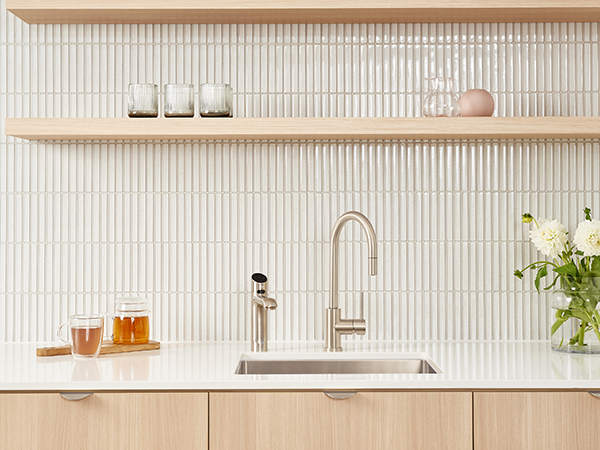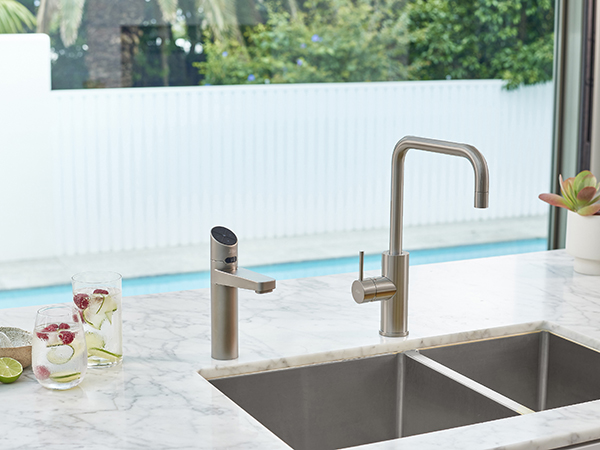From water saving, water recycling and water storage, to a range of water minimisation strategies there are many concepts on the market designed to keep usage of water down to a minimum.
One such company dedicated to finding solutions in this area is Australian designer and distributor of bathroom products, Caroma.
Senior Brand Manager at Caroma Nick Swan says while traditionally metering water was the only way to understand how much had been used, nowadays it’s extremely important to not only know how much has been used but how it has been used and what can be done to improve water usage.
“After the Covid lockdowns, building managers got to see and understand how much water a building is using with and without people in them, so areas such as leak detection have become extremely important, as well as transparency around fixture water usage,” he says.
“With tenants reducing their use of public transport and an increase in cycling and the lifestyle facilities close to the office, end-of-trip facilities are becoming more important than ever. Building owners and managers are arming themselves with the best facilities to attract the best tenants, whilst minimising water consumption”.

To help customers be transparent with their water usage and improve water efficiency, Caroma has developed Smart Command, an eco-system of Bluetooth-connected bathroom fixtures that aid in the day-to-day water, hygiene, and maintenance management of the building.
Caroma Smart Command provides building managers with never seen data and insights into their building's water usage. This assists with informed, proactive decision-making to help save every drop of water.
The Caroma Smart Command eco-system includes touchless tapware and toilet flush panels, smart electronic urinal rough-ins, intelligent shower interfaces, and an Australian first – a smart leak detection valve. All can poll data in real-time to the Smart Command Cloud where building and facility managers can understand their water usage, track trends, run reports, and receive alerts.
“Our Caroma Smart Command Eco-Valve can detect and isolates major or minor leaks which can save a significant amount of water, and damage, for the building,” Swan says.
“To help with the demand for the end-of-trip, we have the Caroma Smart Command Intelligent Shower, which uses a touch screen interface to display the duration, the temperature and the water used in the shower to enhance the experience, whilst also encouraging significant water saving through restrictions, behavioural nudges, or water recapture,” he explains.
The full product suite of Caroma Smart Command can be seen in the bathrooms across all floors of Melbourne’s Market Lane development. Positioned just east of Melbourne’s famous South Melbourne Market, Hickory’s Market Lane development is being dubbed the ‘non-office’ office.
The five-level, mixed-use commercial building is made up of office accommodation, ground floor retail space as well as a hotel-standard end-of-trip facility in the basement.
A total of 145 Caroma Smart Command fixtures and fittings were installed across the bathrooms. So far, a total of 37KL of water savings have been seen with 486KL of total yearly projected water savings.
Smart Command is also having positive results on water management at The Glasshouse, a 35,144sqm office building in Macquarie Park, Sydney. With a total capacity of 3,000 people, it’s essential that the Glass House building operates as sustainably as possible to minimise water wastage.
Caroma was contracted to install sustainable fittings in all bathrooms throughout the building. This saw 237 Touchless Toilet Panels, 44 Automatic Urinal flush Valves, 156 Sensor Taps, and 12 Leak Detection Eco Valves from the Caroma Smart Command range installed. The 449 Caroma Smart Command fixtures and fittings provided a way to measure and reduce water usage; cut water usage in bathrooms by 10% and provide insight on how to improve that figure. The Smart Command system is also helping the building and facility managers understand how to drive costs down by providing a pathway to maintenance cost reductions.
At current occupancy levels, Caroma Smart Command has delivered 117KL in water savings through a combination of leak detection and optimised tapware usage. The data gathered was able to demonstrate clearly where behavioural improvements in half-flushes and greater usage of male urinals rather than toilets could have a measurable impact on water consumption. If these direct water savings and monitored behavioural improvements are extended to full occupancy, the eco-system is expected to drive a total 2,309KL in water savings across direct and behavioural measurements, saving more than $8,000 in costs and almost 2000kg of carbon emissions.
Galvin Engineering also sees the water-saving benefits of sensor-operated tapware combined with either Bluetooth or a monitoring system.
Galvin Engineering’s Business Unit Manager - Health and Corrections, Clive Berrell says when it comes to water systems, many contemporary approaches to design and daily operations focus on water conservation. While this is positive and water-saving measures help hospitals and other health care facilities adhere to sustainability benchmarks, he noted that there can be negative, unintended consequences when it comes to the risk of contamination of water systems. He says this is a result of many facilities “harbouring water in their systems for much longer than they were previously”.
“In addition, many facilities do not have systems in place to be able to determine how their water system is performing in terms of temperatures and levels of flow,” he explains.
“Preventing conditions that lead to biofilm, growth of bacteria, and disease spread, all start with best-practice design of hydraulic systems. Various configurations for the design of water systems will be shaped by the type and layout of a building and its use, however, a key requirement for such systems generally is the need to incorporate a means of disinfecting and draining the system”.
He says Environmentally Sustainable Design (ESD) principles are not at odds with maintaining healthy water systems. It’s more accurate, however, to say that developing better methods to control water quality risks can be a neglected aspect of sustainable design.
To maintain healthy water systems whilst still being conscious of saving water, Galvin Engineering has hands-free sensor tapware that enables automatic flushing and thermal disinfection of fixtures for optimal Legionella control.
The tapware can be integrated with Bluetooth connectivity to enable easy adjustment of run time settings and sanitary flushing from a mobile device or with a wireless cloud-based CliniMix TMV Monitoring and Compliance System which provides high-level insights into product and plumbing systems. These added features help to accurately gauge water flow and temperatures.
“A key difference between CliniMix and other solutions on the market is the integral Flow Switch, which measures real-time water movement and the timing of water flow to within one second,” he says.
“The solution identifies which specific valves have been used, and for how long, alerting about valves that remain unused for more than seven days so they may be flushed”.
All information from the water system is collected and stored, providing effortless record-keeping and reporting. It also gives the opportunity for a deep dive into the data: to compare performance over time to track progress, revise targets, or inform operational improvements.
Another popular water solution that helps people reduce their reliance on single-use plastic bottles while ensuring a safe, clean water supply is filtered taps.
Zip Water’s HydroTap offers boiling, chilled, and sparkling water at the press of a button. Every HydroTap comes with a smart under-bench command centre that features customisable settings with three energy-saving modes including ON/OFF timers and a sensor-activated 'sleep when it's dark’ mode to help conserve energy during periods of low or non-usage.
The tap’s closed refrigeration forced air-cooled systems are 100% water efficient with rapid chilling and heat transfer capabilities delivering consistently colder chilled water. Forced air cooling removes waste heat that is generated as part of the refrigeration process for cooling water. This means no water is used as part of this process, making it 100% water efficient

Manufacturer and supplier of quality drinking water and washroom systems, Billi, also offer instant filtered boiling, chilled and sparkling water systems. Billi’s Eco and Quadra environmentally friendly water filter systems, for example, use technology that recovers and reuses energy. They help to meet the Green Building Design objectives by applying thermodynamic heat-exchange technology which recovers and reuses heat energy, deploying high-performance polyethylene insulation that retains water temperature and saves energy, and offers standby modes that conserve power during set non-use periods.
When it comes to considering more sustainable water usage in built environments, it’s also important to look right back to where manufacturing begins, says Cosentino vice-president of Oceania Itay Shimony.
“The building industry is currently one of the most responsible, for both the depletion of natural resources and the generation of emissions and waste. Therefore, there’s a great opportunity to implement improvements in the construction industry that try to solve the problems of modern cities in terms of water resource management,” he explains.
Cosentino not only is known for its state-of-the-art architectural surfaces but also for its genuine commitment to sustainability
Shimony notes that at a product manufacturing level, the water used is 99% recycled origin.
Cosentino’s philosophy is that every drop of water has an owner: society as a whole. That is why they strive not to waste a single drop: instead reusing it in the production process or in the irrigation of green areas. They practice a policy of water recirculation in the production process, which allows them to be increasingly efficient in the use of available water.
“In 2022, we will inaugurate our own wastewater regeneration plant, which will allow us to ensure that all the water used in the manufacturing process is 100% recycled,” Shimony says.
Ultimately, water is an incredibly precious resource, and this is becoming increasingly front of mind in the manufacturing and design industries. This means companies are seeking out more effective water resource management solutions to deliver to the growing number of eco-conscious clients who want to play their part in a more sustainable future.
Images: https://www.rmit.edu.au/about/our-values/sustainability/sustainable-development-goals/projects/sustainable-water-management-system
Suppliers
Caroma:
Galvin Engineering:
Zip Water:
Cosentino:
Billi:

